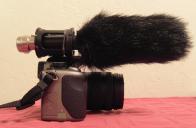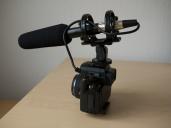
It allows to keep PV going, with more focus towards AI, but keeping be one of the few truly independent places.
-
Here is a small secret: some microphones that require phantom power with a minimum of 9-12 V will operate happily using the 2.5-v "plug-in" power provided by the GH2's mic port. I have my GH2 set up with the Audio-Technica AT875R, and I am very pleased with the results.
More details: http://personal-view.com/talks/discussion/3197/at875r-mic-phantom-powered-directly-by-the-gh2#Item_7
Audio samples: http://personal-view.com/talks/discussion/3197/at875r-mic-phantom-powered-directly-by-the-gh2#Item_11
Which phantom powered mics will operate on such a low voltage? Electret condenser mics (i.e. permanently charged) are good candidates. You'll also want a mic with high sensitivity, to give a high SNR given the noise of the GH2's pre-amps and the quantization noise of 16-bit samples. I speculate that mics that can operate on a low-voltage battery are good candidates. But ultimately you'll have to test the mic to see how well it works. Here's more info: http://recording.org/pro-audio-gear/30016-phantom-power-is-a-mystery.html
How do you wire the mic cable? From my testing, the AT875R can be wired with XLR pin 3 unconnected, or shorted to pin 1, which apparently means it is impedance balanced. Here are wiring references:
http://www.audio-technica.com/cms/site/4ffc7039c199613a/index.html/index.html#unbalancedinput http://www.benchmarkmedia.com/discuss/feedback/newsletter/2008/05/2/helpful-how-tos-how-properly-connect-balanced-outputs-unbalanced-inputYou must lose something by operating the mic under spec, right? Generally speaking, the max sound pressure level before distortion will be reduced somewhat, and the sensitivity will be reduced a tiny bit. Judging by the specs of other Audio-Technica shotgun mics that can operate on phantom power or from a 1.5-V battery, the max SPL is reduced by about 10 dB. Even with that reduction, the max SPL is still quite high - so high that if you are in that environment, you better be wearing earplugs. I tested some loud sounds, and I was getting distortion inside the GH2 with the mic level setting set to 1 (the lowest gain setting) before I got any distortion from the mic.
Of course the weak point in any GH2 mic connection is the 2.5-mm jack. I got the highest quality cable with a right-angle connector that I could find, and made my cable just the right length to keep it secure and out of the way. The link is unbalanced, so to minimize interference, use a shielded cable and keep it short.
The GH2's lack of real-time audio monitoring prevents the use of the mic port for any application in which the audio is critical. But you can work around the lack of monitoring to a certain extent. Plug the mic into something that does allow monitoring (e.g. the Zoom H1), and do some walk-around tests to identify problems. I found and eliminated noise coming from my shock mount, cable, and XLR connector. You can also record a short test video and play it back and listen through the GH2's terrible, tiny speaker before shooting.
The shock mount configuration in my photos is intended to have a very low profile. A more standard configuration would put the shock mount higher and allow for the use of wide-angle lenses. But in my configuration the mic is out of the view of all of my lenses, including the Lumix 20-mm. I swapped and reconfigured the elastic bands to improve the isolation and give a slight upward tilt that keeps the mic out of the lens's view.
With the GH2 mic level set to 4 (the highest gain setting), speaking in a normal voice from about 3 feet in front of the mic puts the meter at 7 bars, just into the red.
Compared to the MKE-400, the AT875R has better rejection of off-axis sounds, and the shock mount I'm using performs much, much better than the one built into the MKE-400. I might have been satisfied with the MKE-400, except for its shock mount. Every time my finger touched the camera, you could hear it in the recording.
Where to get mike:

 GH2 with AT875R, angled view cropped.jpg700 x 447 - 134K
GH2 with AT875R, angled view cropped.jpg700 x 447 - 134K
 GH2 with AT875R, left side view cropped.jpg700 x 499 - 124K
GH2 with AT875R, left side view cropped.jpg700 x 499 - 124K
 GH2 with AT875R, right side view cropped.jpg700 x 457 - 102K
GH2 with AT875R, right side view cropped.jpg700 x 457 - 102K -
Wow, I have a AT875R and wondered about this. Was thinking of spending money towards a Videomic Pro, but if this works, it will save me money!
@balazer I found a premade cable. Will this work?
If it does, I will buy immediately and try out. It is not an angled XLR but it will do. And I have a 2.5mm to 3.5mm adapter.
-
@balazer I will try out. It's not expensive. If it doesn't work, I can always try to create own one. I do hope it does work.
-
- AT875R microphone: http://www.amazon.com/Audio-Technica-Gradient-Shotgun-Condenser-Microphone/dp/B000BQ79W0/
- WindTech Mic-Muff MM-25 fur windshield: http://www.bhphotovideo.com/c/product/538882-REG/WindTech_MM_25_MM_25_Fur_Fitted_Microphone.html
- Vaster 2.5-mm angled 3-ft patch cable (SKU 20568-3): http://www.cableclub.com/angled-25mm-stereo-male-male-mini-plug-patch-cable-p-3817.html?osCsid=d0995efb78e6fedc60c76c89fe97f884
- 3-pin XLR Female Right Angle Connector: http://www.ebay.com/itm/320831912940?ssPageName=STRK:MEWNX:IT&_trksid=p3984.m1439.l2649
- Adorama Flashpoint shock mount: http://www.adorama.com/FPMCS.html
- Walgreens silicone rubber bands: http://www.walgreens.com/store/c/studio-35-beauty-silicone-rubberbands/ID=prod6031349-product
- 25-mm tall 1/4" screw hot shoe adapter: http://www.ebay.com/sch/i.html?_nkw=1%2F4+screw+shoe+adapter&_sacat=625&_odkw=1%2F4+shoe+adapter&_osacat=625&_trksid=p3286.c0.m270.l1313
- 1/4"-20 bar knob (I found them at Lowe's)
The cable is wired with XLR pin 2 to the tip and ring of the 2.5-mm connector, and XLR pins 1 and 3 to the sleeve of the 2.5-mm connector. It also works to leave XLR pin 3 disconnected.
The particular XLR connector that I used had looseness between the connector part and the housing, allowing it to rattle sometimes. I corrected the problem by putting some silicone rubber bands underneath the housing cover, so that the connector is squeezed tight against the housing.
Here's a painstakingly detailed video showing how I reconfigured and mounted the shock mount.
-
A related idea: say you've got a mic that can operate on a single 1.5-V battery or phantom power, but the voltage regulator circuit in the mic won't accept phantom power as low as the 2.5 V provided by the GH2. I think you could build a simple circuit with a DC blocking capacitor to direct the GH2's plug-in power to the battery terminals, and connect the signal lines to the XLR connector with the DC bias filtered out. Here's a wiring reference: http://www.rcrowley.com/CamAdapt.htm
Maybe it's easier to just use a battery, but I do see value in getting rid of an extra battery and an extra power switch. Having an extra battery and power switch, and not having a LED indicator to show you that the mic is turned on (and most battery powered mics don't), means there's a good chance you'll forget to turn it off when you're done shooting, which means you might have a dead battery next time you go to shoot. Also, there's a chance you'll forget to turn the mic on when you begin shooting. A well-stocked videographer will always have spare batteries in his bag.
-
@balazer Thanks a lot for the good stuff. About the xlr cable, would something like this work?
-
I have uploaded short test videos of the AT875R, MKE-400, and the GH2's built-in mic. The camera was 3.5 feet away. The audio is original, all recorded in the GH2. (download the source files) The GH2's recording level was set to 4, and the MKE-400's boost setting was off.
http://minus.com/mGH2_mic_tests/1g
stonebat, that cable isn't wired correctly for the GH2 and AT875R. It's meant for connecting a stereo mic to a stereo input. The mono-to-stereo cable is the one that's more likely to work. The stereo-to-stereo cable would probably work, but you'd only get sound in one channel.
-
@stonebat I have bought the Hosa XVM-101F (that's the mono to stereo version), but it may take a week before it arrives. Will report if it works once I have it.
-
ssh, I've added a boost/no-boost MKE-400 comparison.
http://minus.com/mGH2_mic_tests/1g
Using the MKE-400's boost setting seems to reduce its noise somewhat.
-
@balazer Great topic! Great inspiration! AT875 sounds much better than the MKE400. Was never a real fan of it neither of the Rode Video Mics. Since a long time I am thinking about a really good sound solution for the GH2. I am working now with an azden mic support which is not very high, so its fine for me and for now I was using a normal length shotgun with a 1.5V battery. The shorter version of that mic is not so directional, I prefer the longer one. Regarding the mono-stereo issue: If you solder a "bridge" between the two channels of the 2.5 stereo plug, you a have the mono signal on both GH2 channels. A few month ago I tried the classic interview electrovoice 635A (omni-directional) dynamic mic into the GH2 (I think with a low to high impedance matching adapter cable, not sure) and it sounded very nice. So I thought to try out the Beyerdynamic M201TG (which is even 1 inch shorter than the AT875), but with very directional characteristics - off-axis noise rejection - and see how that sounds for voice recording. The M201TG is one of the best mics since ever, don't know if its good for our purposes. Does anybody have this mic and can test it?
-
Those are dynamic mics, with lower sensitivity. I think you need a really good pre-amp to get good results with them for anything except loud or close subjects. Did you get a loud enough signal from your Electro-voice 635A into the GH2?
The mono-to-stereo cable wiring I described earlier gives you sound on both channels. You can't use the stereo-to-stereo cable and bridge the two channels. That would short XLR pin 2 to pin 3, which means you'd get no sound.
The wiring I described is suitable for most mics that require phantom power. But technically, my cable wiring is not supplying phantom power, since it doesn't put the same voltage on pins 2 and 3. So it might not be a good thing to try with a dynamic mic. The current could damage a dynamic mic. For a dynamic mic, I think you need a blocking capacitor. This wiring should work: tip and ring to a DC-blocking capacitor and then to XLR pin 2; sleeve to XLR pin 3. Connecting just the tip or ring instead of both gives you a little more sensitivity, and sound on just one channel. I don't know if there are any issues of impedance matching with the GH2 and dynamic mics.
My whole exercise was to find a good mic that would work well with the GH2, rather than finding a way to adapt any good mic to the GH2. To use any good mic, you really need a pre-amp with more gain and less noise, and phantom power at 12 or 48 volts.
-
This is what you need for dynamic microphones: http://www.ebay.com/itm/Pearstone-LMT100-Low-to-High-Impedance-Matching-Transformer-1-5-/110825168019?pt=LH_DefaultDomain_0&hash=item19cdb1dc93#ht_1363wt_1111
-
I don't think impedance conversion is required to use these dynamic microphones with the GH2. They are low impedance microphones. You just need to block the DC voltage. The bigger issue with dynamic mics is their low sensitivity. Used with the GH2 and without an external pre-amp, they will only be suitable for loud or close subjects.
-
@stonebat I have received the Hosa XVM-101F (that's the mono to stereo version), and it works! The cable is just long enough to put the AT875R on a Rode camera shock mount. Seems to give plenty of level too for short distances (meaning standing directly in front of the camera).
It's this cable, but I bought it on eBay: http://www.hosatech.com/product/443984/XVM-101F/_/Microphone_Cable%2C_XLR3F_to_Right-angle_3.5_mm_TRS%2C_1_ft
Yes, it is not an angled cable, so it does stick out much, but at least it works! Because it stick out, you can't practically use the EVF without bumping the cable. I will make my own angled cable later when I have the time. The AT875R is one of the best buys I've ever made! So versatile and good quality.
@balazer The wiring of the Hosa cable is exactly as you described: The sleeve to XLR pin 1 and 3, and tip and ring to XLR pin 2. Thanks for letting me save some money!
-
@John_Farragut Cool. Thanks man!!! Let me think about the sticking part, too.
-
Let me think about the sticking part, too.
@stonebat Well, silly me. You can of course suspend the mic further forwards, suspending the XLR plug itself (although the XLR plug is just a tad loose, so I will have to see if it picks up any sound). That way, you have much more clearance. There's still a little bit bumping possible, but much less! It would be even better if the cable went upwards. Here are some pics:

 Hosa1.jpg1024 x 768 - 135K
Hosa1.jpg1024 x 768 - 135K
 Hosa2.jpg1024 x 768 - 134K
Hosa2.jpg1024 x 768 - 134K
Howdy, Stranger!
It looks like you're new here. If you want to get involved, click one of these buttons!
Categories
- Topics List23,986
- Blog5,725
- General and News1,353
- Hacks and Patches1,152
- ↳ Top Settings33
- ↳ Beginners255
- ↳ Archives402
- ↳ Hacks News and Development56
- Cameras2,364
- ↳ Panasonic993
- ↳ Canon118
- ↳ Sony156
- ↳ Nikon96
- ↳ Pentax and Samsung70
- ↳ Olympus and Fujifilm100
- ↳ Compacts and Camcorders300
- ↳ Smartphones for video97
- ↳ Pro Video Cameras191
- ↳ BlackMagic and other raw cameras116
- Skill1,960
- ↳ Business and distribution66
- ↳ Preparation, scripts and legal38
- ↳ Art149
- ↳ Import, Convert, Exporting291
- ↳ Editors191
- ↳ Effects and stunts115
- ↳ Color grading197
- ↳ Sound and Music280
- ↳ Lighting96
- ↳ Software and storage tips266
- Gear5,420
- ↳ Filters, Adapters, Matte boxes344
- ↳ Lenses1,582
- ↳ Follow focus and gears93
- ↳ Sound499
- ↳ Lighting gear314
- ↳ Camera movement230
- ↳ Gimbals and copters302
- ↳ Rigs and related stuff273
- ↳ Power solutions83
- ↳ Monitors and viewfinders340
- ↳ Tripods and fluid heads139
- ↳ Storage286
- ↳ Computers and studio gear560
- ↳ VR and 3D248
- Showcase1,859
- Marketplace2,834
- Offtopic1,319







